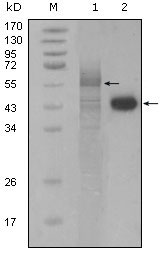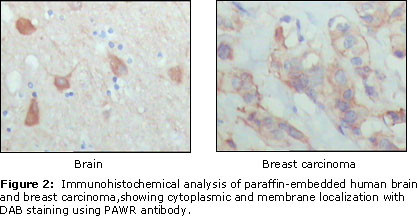PAR4 Antibody
Purified Mouse Monoclonal Antibody
- 产品详情
- 实验流程
Application
| WB, IHC, E |
|---|---|
| Primary Accession | Q96IZ0 |
| Reactivity | Human |
| Host | Mouse |
| Clonality | Monoclonal |
| Clone Names | 3G9H7; 4H12E9 |
| Isotype | IgG1 |
| Calculated MW | 36568 Da |
| Description | Prostate apoptosis response 4 (Par4) is a 38kD protein originally identified as the product of a gene that is upregulated in prostate tumor cells undergoing apoptosis. It is a leucine zipper and death domain containing protein whose levels increase in neurons undergoing apoptosis as a result of trophic factor withdrawal or exposure to oxidative and metabolic insults. Par4 levels are reported to be increased in their lumbar spinal cord specimens further suggesting a role in neuronal degeneration. The tumor suppressor WT1 represses and activates transcription. The loss and/or imbalance of the dual transcriptional activity of WT1 may contribute to Wilms tumor. Par4 is a WT1 interacting protein that also functions as a transcriptional repressor. |
| Immunogen | Purified recombinant fragment of PAR4(aa1-330) expressed in E. Coli. |
| Formulation | Ascitic fluid containing 0.03% sodium azide. |
| Gene ID | 5074 |
|---|---|
| Other Names | PRKC apoptosis WT1 regulator protein, Prostate apoptosis response 4 protein, Par-4, PAWR, PAR4 |
| Dilution | WB~~1/500 - 1/2000 IHC~~1/500 - 1/2000 E~~N/A |
| Storage | Maintain refrigerated at 2-8°C for up to 6 months. For long term storage store at -20°C in small aliquots to prevent freeze-thaw cycles. |
| Precautions | PAR4 Antibody is for research use only and not for use in diagnostic or therapeutic procedures. |
| Name | PAWR |
|---|---|
| Synonyms | PAR4 |
| Function | Pro-apoptotic protein capable of selectively inducing apoptosis in cancer cells, sensitizing the cells to diverse apoptotic stimuli and causing regression of tumors in animal models. Induces apoptosis in certain cancer cells by activation of the Fas prodeath pathway and coparallel inhibition of NF-kappa-B transcriptional activity. Inhibits the transcriptional activation and augments the transcriptional repression mediated by WT1. Down-regulates the anti- apoptotic protein BCL2 via its interaction with WT1. Also seems to be a transcriptional repressor by itself. May be directly involved in regulating the amyloid precursor protein (APP) cleavage activity of BACE1. |
| Cellular Location | Cytoplasm. Nucleus. Note=Mainly cytoplasmic in absence of apoptosis signal and in normal cells. Nuclear in most cancer cell lines. Nuclear entry seems to be essential but not sufficient for apoptosis (By similarity). Nuclear localization includes nucleoplasm and PML nuclear bodies. |
| Tissue Location | Widely expressed. Expression is elevated in various neurodegenerative diseases such as amyotrophic lateral sclerosis, Alzheimer, Parkinson and Huntington diseases and stroke. Down-regulated in several cancers. |
Research Areas
For Research Use Only. Not For Use In Diagnostic Procedures.
Application Protocols
Provided below are standard protocols that you may find useful for product applications.
REFERENCES
1. J Biol Chem. 2004 Jul 2;279(27):28266-75. 2. Exp Hematol. 2004 Jul;32(7):649-56. 3. Mol Cell Biol. 2005 Feb;25(3):1146-61. 4. Psychiatr Genet. 2006 Oct;16(5):193-6.
终于等到您。ABCEPTA(百远生物)抗体产品。
点击下方“我要评价 ”按钮提交您的反馈信息,您的反馈和评价是我们最宝贵的财富之一,
我们将在1-3个工作日内处理您的反馈信息。
如有疑问,联系:0512-88856768 tech-china@abcepta.com.























 癌症的基本特征包括细胞增殖、血管生成、迁移、凋亡逃避机制和细胞永生等。找到癌症发生过程中这些通路的关键标记物和对应的抗体用于检测至关重要。
癌症的基本特征包括细胞增殖、血管生成、迁移、凋亡逃避机制和细胞永生等。找到癌症发生过程中这些通路的关键标记物和对应的抗体用于检测至关重要。 为您推荐一个泛素化位点预测神器——泛素化分析工具,可以为您的蛋白的泛素化位点作出预测和评分。
为您推荐一个泛素化位点预测神器——泛素化分析工具,可以为您的蛋白的泛素化位点作出预测和评分。 细胞自噬受体图形绘图工具为你的蛋白的细胞受体结合位点作出预测和评分,识别结合到自噬通路中的蛋白是非常重要的,便于让我们理解自噬在正常生理、病理过程中的作用,如发育、细胞分化、神经退化性疾病、压力条件下、感染和癌症。
细胞自噬受体图形绘图工具为你的蛋白的细胞受体结合位点作出预测和评分,识别结合到自噬通路中的蛋白是非常重要的,便于让我们理解自噬在正常生理、病理过程中的作用,如发育、细胞分化、神经退化性疾病、压力条件下、感染和癌症。








